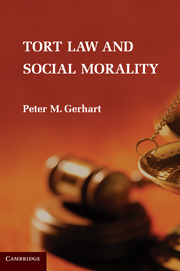2 - Social Cohesion and Social Values: The Reasonable Person
Published online by Cambridge University Press: 04 August 2010
Summary
Open-ended, undefined, and context-contingent, the reasonable person standard is both the central pillar on which tort law is built and a source of mystery about the content and function of tort law. The standard definitions are circular, not a source of analytical or justificational understanding. And the attempt to give the reasonable person concept an analytical and justificational core by invoking the relative costs and benefits of various courses of action – the Hand formula – has fueled the divide between consequential and deontic theories.
But the mystery and division are unwarranted if we understand the reasonable person in light of the theory of other-regarding behavior. In this chapter, I give the reasonable person concept analytical and justificational content by advancing my claim that the reasonable person is one who appropriately accounts for the well-being of others in a way that promotes social cohesion. Central to this account is a portrayal of the source of the values that reasonable people use in order to be appropriately other-regarding. An actor's responsibility is to adopt a method of making decisions that allows the actor to give appropriate weight to the projects and preferences of others – to internalize, in an appropriate way, the social value of the projects and preferences of others into the decisions the actor makes.
THE CURRENT UNDERSTANDING
This conception of the reasonable person builds on our current understanding of the analytical and functional content of tort law.
- Type
- Chapter
- Information
- Tort Law and Social Morality , pp. 24 - 58Publisher: Cambridge University PressPrint publication year: 2010



